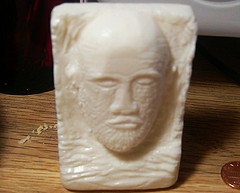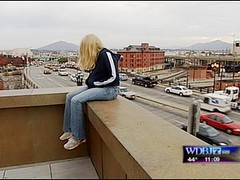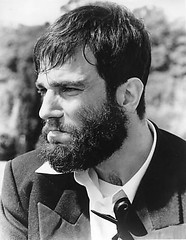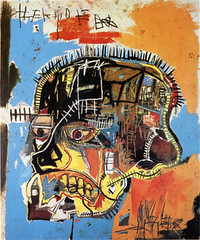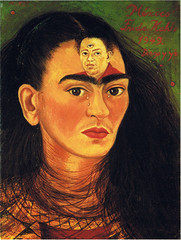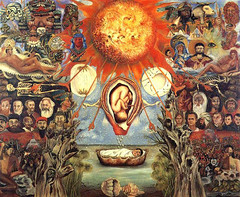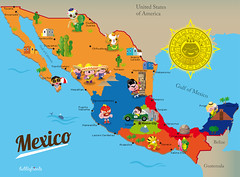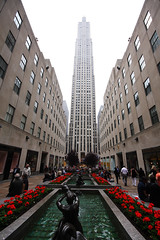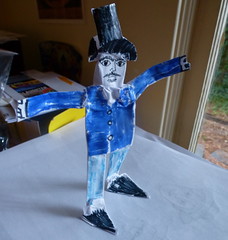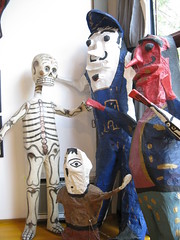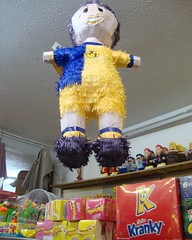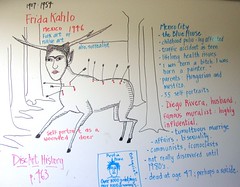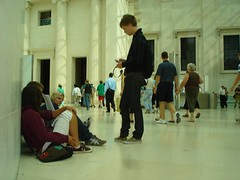Venus figurines is an umbrella term for a number of prehistoric statuettes of women portrayed with similar physical attributes from the Upper Palaeolithic, mostly found in Europe, says Wikipedia.
Their distribution ranges across Eurasia, from the Pyrenees to Lake Baikal. The dates of these man-made pieces ranges from 35,000 years ago to about 11,000 years.
These figurines were carved from soft stone such as steatite, calcite or limestone. Or were fashioned from bone or ivory, or formed of clay and fired. The latter are among the oldest ceramics known.
In total, over a hundred such figurines are known; virtually all of modest size, between 4 cm and 25 cm in height. They are some of the earliest works of prehistoric art.
Thursday, August 30, 2012
Wednesday, August 29, 2012
Each fine arts student: 3 bars of soap to be sculpted Sept 10 - 11
In the fine arts survey of sculpture, there is more to experience. It is sculpting in the malleable medium of soap:
- one piece in sunken relief
- a work in raised relief, or bas relief
- a piece of simple free-standing sculpture
Three "full-size" soap bars. Highest recommendation: 3 bars of Ivory soap. Perhaps team up w classmates and buy a large pkg to be divided in class.
You may bring a sculpting stylus ( stylus (plural: styli) is a writing utensil, or a small tool for some other form of marking or shaping, for example in pottery) or use the random utensils - mostly large paper clips - that are in e205.
12 pts for soap and completion.
Following this adventure you will compose a one-page descriptive essay that compares work performed on the maquette, the body cast and soap work. 15 pts.
- one piece in sunken relief
- a work in raised relief, or bas relief
- a piece of simple free-standing sculpture
Three "full-size" soap bars. Highest recommendation: 3 bars of Ivory soap. Perhaps team up w classmates and buy a large pkg to be divided in class.
You may bring a sculpting stylus ( stylus (plural: styli) is a writing utensil, or a small tool for some other form of marking or shaping, for example in pottery) or use the random utensils - mostly large paper clips - that are in e205.
12 pts for soap and completion.
Following this adventure you will compose a one-page descriptive essay that compares work performed on the maquette, the body cast and soap work. 15 pts.
Friday, August 24, 2012
NYC!
A man with a hat of tan!
From the map on the blog, name the section of Manhattan:
1. Wall St.
2. Broadway theater district.
3. Oldest residential area.
4. Denizens are known for their wealth.
5. Carnegie Hall and the Plaza Hotel.
6. University adjacent to Harlem.
7. "Rent" is the story of struggling, creative young people in the __ __ .
8. Long-time center for immigrants, usually the impoverished ones.
9. Process of refurbushing and upgrading old and run-down buidings and neighborhoods.
10. Most northerly borough of NYC.
11. Harlem's classification: a) neighborhood b) borough.
From the map on the blog, name the section of Manhattan:
1. Wall St.
2. Broadway theater district.
3. Oldest residential area.
4. Denizens are known for their wealth.
5. Carnegie Hall and the Plaza Hotel.
6. University adjacent to Harlem.
7. "Rent" is the story of struggling, creative young people in the __ __ .
8. Long-time center for immigrants, usually the impoverished ones.
9. Process of refurbushing and upgrading old and run-down buidings and neighborhoods.
10. Most northerly borough of NYC.
11. Harlem's classification: a) neighborhood b) borough.
Thursday, August 23, 2012
Life-like and alarming: Mark Jenkins sculpture, Taubman Museum, Roanoke, Va
MARK Jenkins creates lifelike sculptures that he fashions out of packing tape and his girlfriend's clothes, says Taubmanmuseum.org.
He places his creations in natural settings, such as streets in places around the world, including Washington, D.C., and Prato, Italy.
One of Jenkins' sculptures had to be removed from its original location on an outdoor terrace of the Taubman because people thought there was a person precariously sitting on the edge and flooded the police with phone calls.
Jenkins said he wasn't bothered by the removal of his statue.
"Most of my pieces have a short lifespan when they are out on the street," Jenkins said.
Jenkins said his works were intentionally not given their own gallery to make viewers experience the full effect of his art.
"My pieces don't have title cards in the museum. I'm not mentioned in many of the press releases. I wanted to play with people. I wanted to catch people off guard."
His sculpture is of a man lying down in the fetal position on the floor in a corner of a gallery of 17th century Italian art wearing tennis shoes and a plaid button shirt.
He places his creations in natural settings, such as streets in places around the world, including Washington, D.C., and Prato, Italy.
One of Jenkins' sculptures had to be removed from its original location on an outdoor terrace of the Taubman because people thought there was a person precariously sitting on the edge and flooded the police with phone calls.
Jenkins said he wasn't bothered by the removal of his statue.
"Most of my pieces have a short lifespan when they are out on the street," Jenkins said.
Jenkins said his works were intentionally not given their own gallery to make viewers experience the full effect of his art.
"My pieces don't have title cards in the museum. I'm not mentioned in many of the press releases. I wanted to play with people. I wanted to catch people off guard."
His sculpture is of a man lying down in the fetal position on the floor in a corner of a gallery of 17th century Italian art wearing tennis shoes and a plaid button shirt.
Wednesday, August 22, 2012
One of the nine commandments of fine arts survey: know Manhattan
Manhattan's most famous sections. Commit to memory, please.
1. Harlem (center of jazz history and Afr-Amer culture).
2. Morningside Heights (Columbia Univ)
3. Upper West Side (Madonna, John Lennon, other rich & powerfuls)
4. Upper East Side (more of the wealthy class)
5. Midtown - Broadway, Carnegie Hall, etc
6. Chelsea - art, shopping, high-tech, gay life.
7. Greenwich Village - oldest historic neighborhood; once cheap housing for bohemians, today gentrified.
8. East Village - hip music & art scene - "Rent" was set here.
9. Lower East Side - center for impoverished immigrants; today undergoing gentrification.
10. SoHo - historic; art, shopping, restaurants, etc.
11. L'Italy, Chinatown - today dominated by Chinese immigrants.
12. Tribeca - fashionable historic warehouse district.
13. Lower Manhattan - original site of NYC; Wall St financial district, Battery Park, former site of WTC.
14. East R
15. Hudson R
16. Brooklyn
17. Bronx
18. New Jersey
1. Harlem (center of jazz history and Afr-Amer culture).
2. Morningside Heights (Columbia Univ)
3. Upper West Side (Madonna, John Lennon, other rich & powerfuls)
4. Upper East Side (more of the wealthy class)
5. Midtown - Broadway, Carnegie Hall, etc
6. Chelsea - art, shopping, high-tech, gay life.
7. Greenwich Village - oldest historic neighborhood; once cheap housing for bohemians, today gentrified.
8. East Village - hip music & art scene - "Rent" was set here.
9. Lower East Side - center for impoverished immigrants; today undergoing gentrification.
10. SoHo - historic; art, shopping, restaurants, etc.
11. L'Italy, Chinatown - today dominated by Chinese immigrants.
12. Tribeca - fashionable historic warehouse district.
13. Lower Manhattan - original site of NYC; Wall St financial district, Battery Park, former site of WTC.
14. East R
15. Hudson R
16. Brooklyn
17. Bronx
18. New Jersey
Tuesday, August 21, 2012
Exploring additional dimensions via tape in a body cast sculpture in class
Students will be given time in class to make body casts in packing tape. Please work in groups - share the tape expense as well as the design, decisions and the wrapping and cutting. Groups will comprise a model and 2 taper/cutters.
You may experiment: duct tape is also very effective. Other types of packing tape may also work.
Do your research via the many projects to be observed on youtube. Here's one from an art student: http://www.youtube.com/watch?v=1PnXCqOnYVU&list=FLMGfC3rFoLTKSFDVEJJZFNg&feature=mh_lolz
To minimize complications, students will Not wrap their heads with tape. I will borrow a wig mannequin for the head form.
10 pts.
If you'd like an alternative assignment it will be a comparison essay on the human sculptures created by the Egyptians and the Greeks. One page.
An artful plan for dressing and displaying the sculptures must also be planned. See the Fort Worth Art Attack video for ideas: http://www.youtube.com/watch?v=gdZHbAU9UiQ&feature=related
You may experiment: duct tape is also very effective. Other types of packing tape may also work.
Do your research via the many projects to be observed on youtube. Here's one from an art student: http://www.youtube.com/watch?v=1PnXCqOnYVU&list=FLMGfC3rFoLTKSFDVEJJZFNg&feature=mh_lolz
To minimize complications, students will Not wrap their heads with tape. I will borrow a wig mannequin for the head form.
10 pts.
If you'd like an alternative assignment it will be a comparison essay on the human sculptures created by the Egyptians and the Greeks. One page.
An artful plan for dressing and displaying the sculptures must also be planned. See the Fort Worth Art Attack video for ideas: http://www.youtube.com/watch?v=gdZHbAU9UiQ&feature=related
Highly recommended: Daniel Day-Lewis in the independent movie My Left Foot
My Left Foot: The Story of Christy Brown is a 1989 drama film directed by Jim Sheridan and starring Daniel Day-Lewis, says Wikipedia.
It tells the true story of Christy Brown, an Irishman born with cerebral palsy, who could control only his left foot. Christy Brown grew up in a poor, working-class family, and became a writer and artist.
It was adapted from the book of the same name by Christy Brown.[2]
Many of the scenes were filmed through a mirror, as Daniel Day-Lewis could only manipulate his right foot to perform the actions seen in the film.[3]
It won the Academy Award for Best Actor (Daniel Day-Lewis) and Best Actress in a Supporting Role (Brenda Fricker). It was also nominated for Best Director, Best Picture and Best Writing, Screenplay Based on Material from Another Medium.
It also won the NYFCC Best Picture Award for 1989.
It tells the true story of Christy Brown, an Irishman born with cerebral palsy, who could control only his left foot. Christy Brown grew up in a poor, working-class family, and became a writer and artist.
It was adapted from the book of the same name by Christy Brown.[2]
Many of the scenes were filmed through a mirror, as Daniel Day-Lewis could only manipulate his right foot to perform the actions seen in the film.[3]
It won the Academy Award for Best Actor (Daniel Day-Lewis) and Best Actress in a Supporting Role (Brenda Fricker). It was also nominated for Best Director, Best Picture and Best Writing, Screenplay Based on Material from Another Medium.
It also won the NYFCC Best Picture Award for 1989.
Monday, August 20, 2012
Two students share a Basquiat painting in class presentations on Aug27-28
The late painter Jean-Michel Basquiat was an enormously influential artist.
Your assignment:
Make a digital-verbal presentation on one of his paintings. Your choice. 15 pts.
Present a series of 5 images.
1. Decode (explicate) major elements of the composition you've chosen. Quote a source or two.
2. Briefly state a cultural event from the year he painted the work. Explain how it was relevant to Basquiat.
3. Brief statement of an event from world or US history that is relevant to the painting or Basquiat. Explain the connection.
4. An image of the artist. Present 3 - 5 biographical details.
5. NYC map showing Brooklyn and the Lower East Side. Explain the importance of NYC to his career.
Also to be included -
- Clever title.
- Documentation: at least 3 sources.
Paintings will be chosen primarily from http://www.wikipaintings.org/en/search/basquiat/1.
Final presentations Sept 4 - 7.
Your assignment:
Make a digital-verbal presentation on one of his paintings. Your choice. 15 pts.
Present a series of 5 images.
1. Decode (explicate) major elements of the composition you've chosen. Quote a source or two.
2. Briefly state a cultural event from the year he painted the work. Explain how it was relevant to Basquiat.
3. Brief statement of an event from world or US history that is relevant to the painting or Basquiat. Explain the connection.
4. An image of the artist. Present 3 - 5 biographical details.
5. NYC map showing Brooklyn and the Lower East Side. Explain the importance of NYC to his career.
Also to be included -
- Clever title.
- Documentation: at least 3 sources.
Paintings will be chosen primarily from http://www.wikipaintings.org/en/search/basquiat/1.
Final presentations Sept 4 - 7.
Young, black and mega-successful: Brooklyn-born painter Jean-Michel Basquiat
Jean-Michel Basquiat (1960 – 1988) was an American artist.[1] He began as an obscure graffiti artist in New York City in the late 1970s, says Wikipedia, and evolved into an acclaimed Neo-expressionist and Primitivist painter by the 1980s.
Throughout his career Basquiat focused on "suggestive dichotomies," such as wealth versus poverty, integration versus segregation, and inner versus outer experience.[2]
Basquiat's art utilized a synergy of appropriation, poetry, drawing and painting, which married text and image, abstraction and figuration, and historical information mixed with contemporary critique.[3]
Utilizing social commentary as a "springboard to deeper truths about the individual",[2] Basquiat's paintings also attacked power structures and systems of racism, while his poetics were acutely political and direct in their criticism of colonialism and support for class struggle.[3]
Throughout his career Basquiat focused on "suggestive dichotomies," such as wealth versus poverty, integration versus segregation, and inner versus outer experience.[2]
Basquiat's art utilized a synergy of appropriation, poetry, drawing and painting, which married text and image, abstraction and figuration, and historical information mixed with contemporary critique.[3]
Utilizing social commentary as a "springboard to deeper truths about the individual",[2] Basquiat's paintings also attacked power structures and systems of racism, while his poetics were acutely political and direct in their criticism of colonialism and support for class struggle.[3]
Frida Kahlo - Self-portrait: Diego y yo {Diego & I} (1949)
Diego and I (1949)
Frida painted this self-portrait during the period when her husband, Diego Rivera, was having a notorious affair with the film star Maria Felix, a relationship which provoked a public scandal.
The beautiful film star was also an intimate friend of Frida's as well, and though Frida pretended to joke about the affair, as she had about Rivera's other escapades, this painting reveals her true emotions. Wretched and weeping, she looks mournfully out at the viewer. Her long hair has wrapped itself around her neck suggesting that she feels strangled by the situation.
As in many of her other self-portraits, her hair again becomes the vehicle through which she expresses her emotional anguish. Frida's obsession with Diego is symbolized by the small bust of him on her forehead ... he being the obvious source of the distress reflected in this painting.
Also see http://tesserae.blogspot.com/2007/10/descriptive-paper.html and http://www.wikipaintings.org/en/frida-kahlo.
Frida painted this self-portrait during the period when her husband, Diego Rivera, was having a notorious affair with the film star Maria Felix, a relationship which provoked a public scandal.
The beautiful film star was also an intimate friend of Frida's as well, and though Frida pretended to joke about the affair, as she had about Rivera's other escapades, this painting reveals her true emotions. Wretched and weeping, she looks mournfully out at the viewer. Her long hair has wrapped itself around her neck suggesting that she feels strangled by the situation.
As in many of her other self-portraits, her hair again becomes the vehicle through which she expresses her emotional anguish. Frida's obsession with Diego is symbolized by the small bust of him on her forehead ... he being the obvious source of the distress reflected in this painting.
Also see http://tesserae.blogspot.com/2007/10/descriptive-paper.html and http://www.wikipaintings.org/en/frida-kahlo.
Friday, August 17, 2012
One-page essay on Frida Kahlo due Aug 21-22
No more than a one-page essay on the passion of Frida Kahlo as seen in her work. On the other hand, make it close to one page so that you do not short yourself on description.
Typed at 1.5 spaces, 18 pt Arial font.
Open with a description of an image from Frida's work and state your theme based upon images from that painting.
Describe and use as your basis for essay 2 more paintings. Explain what we can learn about her life from the elements in each painting. Use paintings that are not similar so that more of her story comes to light.
End your second sentence with the attribution "according to to wikipedia.org."
If you use additional sources, such as Discovering Art History, please document informally.
Jazzy title.
Grammar, construction, spelling.
15 pts.
Typed at 1.5 spaces, 18 pt Arial font.
Open with a description of an image from Frida's work and state your theme based upon images from that painting.
Describe and use as your basis for essay 2 more paintings. Explain what we can learn about her life from the elements in each painting. Use paintings that are not similar so that more of her story comes to light.
End your second sentence with the attribution "according to to wikipedia.org."
If you use additional sources, such as Discovering Art History, please document informally.
Jazzy title.
Grammar, construction, spelling.
15 pts.
Thursday, August 16, 2012
Making the most of a map of Mexico
Mandatory map of Mexico
1. Peninsula on the Pacific coast: __ __.
2. Resort at tip of peninsula on the Pacific / Gulf of California. __ _ __ .
3. Peninsula on the Gulf of Mexico / Caribbean. __
4. Resort island on the Caribbean coast: __ .
5. Resort on the Pacific mainland famous for cliff divers and honeymoon suites: __ .
6. Border town across from San Diego: __ .
7. Border town across from El Ppaso: __ __ .
8. Western mountain range: __ __ __ .
9. Eastern mtn. range __ __ __ .
10. Population of Mexico City: a) 5 M b) 10M c) 22M.
1. Peninsula on the Pacific coast: __ __.
2. Resort at tip of peninsula on the Pacific / Gulf of California. __ _ __ .
3. Peninsula on the Gulf of Mexico / Caribbean. __
4. Resort island on the Caribbean coast: __ .
5. Resort on the Pacific mainland famous for cliff divers and honeymoon suites: __ .
6. Border town across from San Diego: __ .
7. Border town across from El Ppaso: __ __ .
8. Western mountain range: __ __ __ .
9. Eastern mtn. range __ __ __ .
10. Population of Mexico City: a) 5 M b) 10M c) 22M.
Rockefeller Center and the life of Frida and Diego
By 1930, Mexican muralist Diego Rivera has gained international favor for his lush and passionate murals, says PBS.org. Inspired by Communist ideals and an intense devotion to his cultural heritage, Rivera creates boldly hued masterpieces of public art that adorn the municipal buildings of Mexico City.
His outgoing personality puts him at the center of a circle of left-wing painters and poets, and his talent attracts wealthy patrons, including Abby Aldrich Rockefeller. In 1932, she convinces her husband, John D. Rockefeller, Jr., to commission a Rivera mural for the lobby of the soon-to-be-completed Rockefeller Center in New York City.
Flush from successes in San Francisco and Detroit, Rivera proposes a 63-foot-long portrait of workers facing symbolic crossroads of industry, science, socialism, and capitalism. The painter believes that his friendship with the Rockefeller family will allow him to insert an unapproved representation of Soviet leader Vladimir Lenin into a section portraying a May Day parade.
The real decision-making power lies with the Center's building managers, who abhor Rivera's propagandistic approach. Horrified by newspaper articles attacking the mural's anti-capitalist ideology, they order Rivera to remove the offending image.
When Rivera refuses, offering to balance the work with a portrait of Abraham Lincoln on the opposing side, the managers pay his full fee, bar him from the site, and hide the mural behind a massive drape.
Despite negotiations to transfer the work to the Museum of Modern Art and demonstrations by Rivera supporters, near midnight, on February 10th, 1934, Rockefeller Center workmen, carrying axes, demolish the mural.
Later, Rivera recreates the frescoes in the Palace of Fine Arts in Mexico City, adding a portrait of John D. Rockefeller, Jr., in a nightclub. Rivera never works in the United States again, but continues to be active, both politically and artistically, until his death in 1957.
His outgoing personality puts him at the center of a circle of left-wing painters and poets, and his talent attracts wealthy patrons, including Abby Aldrich Rockefeller. In 1932, she convinces her husband, John D. Rockefeller, Jr., to commission a Rivera mural for the lobby of the soon-to-be-completed Rockefeller Center in New York City.
Flush from successes in San Francisco and Detroit, Rivera proposes a 63-foot-long portrait of workers facing symbolic crossroads of industry, science, socialism, and capitalism. The painter believes that his friendship with the Rockefeller family will allow him to insert an unapproved representation of Soviet leader Vladimir Lenin into a section portraying a May Day parade.
The real decision-making power lies with the Center's building managers, who abhor Rivera's propagandistic approach. Horrified by newspaper articles attacking the mural's anti-capitalist ideology, they order Rivera to remove the offending image.
When Rivera refuses, offering to balance the work with a portrait of Abraham Lincoln on the opposing side, the managers pay his full fee, bar him from the site, and hide the mural behind a massive drape.
Despite negotiations to transfer the work to the Museum of Modern Art and demonstrations by Rivera supporters, near midnight, on February 10th, 1934, Rockefeller Center workmen, carrying axes, demolish the mural.
Later, Rivera recreates the frescoes in the Palace of Fine Arts in Mexico City, adding a portrait of John D. Rockefeller, Jr., in a nightclub. Rivera never works in the United States again, but continues to be active, both politically and artistically, until his death in 1957.
Frida Kahlo and the art of the essay
Frida's paintings and a description of the contents, style and symbolism of her works will form the basis for an essay on Frida in fine arts survey.
Instead of writing a stream of generalities - she was fiercely independent, passionate, insightful and adept at art - you will use the descriptions of paintings in describing this rare woman in art.
Above we see the pain and mental anguish that befalls a person who must wear a back brace because of spinal issues. A metal column was surgically implanted in her spine in one attempt to heal her back problems.
Tell the story of Frida via the image of the double house she shared with her husband, Diego, and the portrait of Frida as a wounded deer in the woods. Do not omit mention of the painting of her birth and the painting of the artist dressed in a man's suit.
Instead of writing a stream of generalities - she was fiercely independent, passionate, insightful and adept at art - you will use the descriptions of paintings in describing this rare woman in art.
Above we see the pain and mental anguish that befalls a person who must wear a back brace because of spinal issues. A metal column was surgically implanted in her spine in one attempt to heal her back problems.
Tell the story of Frida via the image of the double house she shared with her husband, Diego, and the portrait of Frida as a wounded deer in the woods. Do not omit mention of the painting of her birth and the painting of the artist dressed in a man's suit.
Formerly homeless teen stabilizes her life with her paintings
"As a child Inocente Izucar moved more than 30 times in nine years — sleeping in crowded quarters beside her three younger brothers under one temporary roof after another, and sometimes even outdoors. Her father was deported to Mexico for domestic abuse. She once stood on a bridge and convinced her mother not to jump," says the NY Times.
"Her art and chronic homelessness are the subject of a short documentary, "Inocente," financed through private donations and grants, that will have its premiere Friday on MTV.
When Ms. Izucar first walked into ARTS at the age of 12 — in her rainbow tutu and high-top sneakers — its founder, Matt D’Arrigo, immediately saw that she had promise. “She’s exactly the kind of person I created this program for,” he said.
Ms. Izucar was selected for the program’s annual art show and given three months to produce 30 pieces, a process the film follows. Over time Ms. Izucar said her work has evolved. “It’s gotten cleaner,” she said. “It still comes from the heart. Every painting has a story.”
"Her art and chronic homelessness are the subject of a short documentary, "Inocente," financed through private donations and grants, that will have its premiere Friday on MTV.
When Ms. Izucar first walked into ARTS at the age of 12 — in her rainbow tutu and high-top sneakers — its founder, Matt D’Arrigo, immediately saw that she had promise. “She’s exactly the kind of person I created this program for,” he said.
Ms. Izucar was selected for the program’s annual art show and given three months to produce 30 pieces, a process the film follows. Over time Ms. Izucar said her work has evolved. “It’s gotten cleaner,” she said. “It still comes from the heart. Every painting has a story.”
Tuesday, August 14, 2012
Judas Figure: a study referred to as a maquette
Maquette: a sculptor's small preliminary model or sketch. From French, from Italian macchietta a little sketch.
Also, a usually small model of an intended work, such as a sculpture or piece of architecture.
In other words, fine arts students might want to make a large and painted Judas Figure. It would be a dramatic piece of work.
Also, a usually small model of an intended work, such as a sculpture or piece of architecture.
In other words, fine arts students might want to make a large and painted Judas Figure. It would be a dramatic piece of work.
Judas Figure construction plan / life of Frida Kahlo
Judas Figures - referring to Judas Iscariot, betrayer of Jesus of Nazareth - are important in Mexican Easter-tide celebrations. These papier mache figures were important elements of celebration in the lives of artists Frida Kahlo and Diego Rivera.
The effigies are blown up with fireworks during Holy Week in Mexico.
By making a paper sculpture based on a folkloric design students will take a developmental step into the world of 3-D art. This construction offers challenges in spatial studies, perspective and patience.
Complete at home if necessary.
Have it in your notebook for viewing.
5 pts.
The effigies are blown up with fireworks during Holy Week in Mexico.
By making a paper sculpture based on a folkloric design students will take a developmental step into the world of 3-D art. This construction offers challenges in spatial studies, perspective and patience.
Complete at home if necessary.
Have it in your notebook for viewing.
5 pts.
Judas figures: ritual burning of evil types by Catholics during Holy Week
In the house/museum of Frida Kahlo, Mexico City, are 2 giant papier mache Judas Figures.
The burning of Judas figures, says Wikipedia, is an Easter-time ritual in many Orthodox and Catholic Christian communities, where an effigy of Judas Iscariot is burned. Other related mistreatment of Judas effigies include hanging, flogging, and exploding with fireworks.
In many parts of Latin America this practice occurs on the eve of the new year as a symbol of ridding one's self of evil and beginning a new year in spiritual purity. Some communities observe this ritual using various effigies, including the biblical Judas (who betrayed Jesus), Satan, a harlot, or a Jew (represented by the stereotypical European depiction of a Jewish male with a goat beard, side locks, and a black frock coat). This custom, during which the effigy is burned on a stake, is invariably called "Quema del Año Viejo"[3] meaning literally "the burning of the old year."
The burning of Judas figures, says Wikipedia, is an Easter-time ritual in many Orthodox and Catholic Christian communities, where an effigy of Judas Iscariot is burned. Other related mistreatment of Judas effigies include hanging, flogging, and exploding with fireworks.
In many parts of Latin America this practice occurs on the eve of the new year as a symbol of ridding one's self of evil and beginning a new year in spiritual purity. Some communities observe this ritual using various effigies, including the biblical Judas (who betrayed Jesus), Satan, a harlot, or a Jew (represented by the stereotypical European depiction of a Jewish male with a goat beard, side locks, and a black frock coat). This custom, during which the effigy is burned on a stake, is invariably called "Quema del Año Viejo"[3] meaning literally "the burning of the old year."
Getting acquainted with Mexico and its art
Habanero and hola! quiz
1. The monumental art form created by indigenous peoples in Mexico: a) cities surrounded by water b) cities carved into rocky promontories c) pyramids.
2. Diego Rivera was a Mexican artist whose peak of fame was in the 1950's. He worked in buildings in the US, Europe and Mexico. His principal art format was probably the a) mural b) tapestry c) relief painting d) sculpture.
3. Name 2 indigenous (native) peoples of Mexico. a) Toltec b) Aryan c) Inca
d) Tartars e) Maya d) Hasinai.
4. Two food resources that originate in Mexico. a) chili peppers b) black pepper c) cacao bean d) vanilla bean e) sugar cane f) barley.
5. Mexico is surrounded by an ocean and 2 seas: __, __ _ ___, __ .
6. The capital city of Mexico: a) Guadalajara b) Monterrey c) Mexico, DF.
7. When you think of El Chicos and Trejo's the term "Mexican food" is not quite the most accurate designation. How should their cooking be classified?
8. Mexico-born and raised actress: a) Salma Hayek b) Annette Benning c) Cate Blanchett d) Meryl Streep.
1. pyramids in both the Yucatan Peninsula and central Mexico. 2. murals and frescoes.
3. Toltec, Aztec, Olmec, Maya. 4. chili pepper, cacao bean, vanilla bean.
5. Pacific, Gulf of Mexico, Caribbean. 6. Mexico, Distrito Federale. 7. Tex-Mex, a hybrid. 8. Salma Hayek.
The artists: Diego Rivera and Frida Kahlo.
1. The monumental art form created by indigenous peoples in Mexico: a) cities surrounded by water b) cities carved into rocky promontories c) pyramids.
2. Diego Rivera was a Mexican artist whose peak of fame was in the 1950's. He worked in buildings in the US, Europe and Mexico. His principal art format was probably the a) mural b) tapestry c) relief painting d) sculpture.
3. Name 2 indigenous (native) peoples of Mexico. a) Toltec b) Aryan c) Inca
d) Tartars e) Maya d) Hasinai.
4. Two food resources that originate in Mexico. a) chili peppers b) black pepper c) cacao bean d) vanilla bean e) sugar cane f) barley.
5. Mexico is surrounded by an ocean and 2 seas: __, __ _ ___, __ .
6. The capital city of Mexico: a) Guadalajara b) Monterrey c) Mexico, DF.
7. When you think of El Chicos and Trejo's the term "Mexican food" is not quite the most accurate designation. How should their cooking be classified?
8. Mexico-born and raised actress: a) Salma Hayek b) Annette Benning c) Cate Blanchett d) Meryl Streep.
1. pyramids in both the Yucatan Peninsula and central Mexico. 2. murals and frescoes.
3. Toltec, Aztec, Olmec, Maya. 4. chili pepper, cacao bean, vanilla bean.
5. Pacific, Gulf of Mexico, Caribbean. 6. Mexico, Distrito Federale. 7. Tex-Mex, a hybrid. 8. Salma Hayek.
The artists: Diego Rivera and Frida Kahlo.
Monday, August 13, 2012
First study, 2012-13: Mexican artist Frida Kahlo and her husband, the painter Diego Rivera
Mexico is an impoverished nation - though there are quite a number of middle class and rich Mexicans - that has a distinct culture.
Mexicans are mostly a blend of indigenous peoples and Europeans.
Frida Kahlo was mestizo (mixed background), like most Mexicans. her mother was Amerindian and her father was German.
Kahlo's life was marked by tragedy. She had polio as a child. As a teen she was in a devastating bus-trolley wreck. Her life was punctuated by surgeries in a continuing attempt to correct spinal and foot problems.
She also married the right / wrong man. Her husband was globally famous for his murals. He was what is called a force majeure. Aka, a player.
Frida, also a wild being, became a player, too.
While in one of her frequent and lengthy periods of convalescence - confined to bed in a plaster cast - she began to paint.
By the 1940's she was known as an accomplished painter in Paris and NYC as well as Mexico.
She painted some 70 self-portraits. They were full of anguish, as you will see.
The biography we will watch on youtube begins here.
You must also learn the basics of Mexico:
the pyramids, the food, the ancient capital cities of Teotihuacan and Tenochtitlan, Moctezuma and Cortez, the folkloric clothing and religious signposts such as Dia de Los Muertos.
Mexicans are mostly a blend of indigenous peoples and Europeans.
Frida Kahlo was mestizo (mixed background), like most Mexicans. her mother was Amerindian and her father was German.
Kahlo's life was marked by tragedy. She had polio as a child. As a teen she was in a devastating bus-trolley wreck. Her life was punctuated by surgeries in a continuing attempt to correct spinal and foot problems.
She also married the right / wrong man. Her husband was globally famous for his murals. He was what is called a force majeure. Aka, a player.
Frida, also a wild being, became a player, too.
While in one of her frequent and lengthy periods of convalescence - confined to bed in a plaster cast - she began to paint.
By the 1940's she was known as an accomplished painter in Paris and NYC as well as Mexico.
She painted some 70 self-portraits. They were full of anguish, as you will see.
The biography we will watch on youtube begins here.
You must also learn the basics of Mexico:
the pyramids, the food, the ancient capital cities of Teotihuacan and Tenochtitlan, Moctezuma and Cortez, the folkloric clothing and religious signposts such as Dia de Los Muertos.
Saturday, August 11, 2012
Review of a British Museum exhibit: "Shakespeare's London, 1612"
"What do a reliquary set with the gouged-out eyeball of a Catholic priest, foot-high platform shoes, and a narwhal tusk have in common? The perhaps surprising answer is that they are all things that would have been known to the audience that packed the Globe Theater to see the plays of William Shakespeare 400 years ago."
- Daisy Goodwin, Newsweek, 8.6.12
See the article: http://www.thedailybeast.com/newsweek/2012/08/05/shakespeare-staging-the-world-at-the-british-museum.html
- Daisy Goodwin, Newsweek, 8.6.12
See the article: http://www.thedailybeast.com/newsweek/2012/08/05/shakespeare-staging-the-world-at-the-british-museum.html
Friday, August 3, 2012
El Anatsui, Nigerian artist whose sculpture is made from stitching discarded materials together with copper wire
The globally-celebrated artist El Anatsui became famous by creating giant tapestries from materials such as bottle tops, soda cans, etc.
Construction of these pieces is a labor-intensive activity.
Please see an explantory video at http://www.youtube.com/watch?v=G7UBvknG8c4.
Construction of these pieces is a labor-intensive activity.
Please see an explantory video at http://www.youtube.com/watch?v=G7UBvknG8c4.
Subscribe to:
Posts (Atom)

